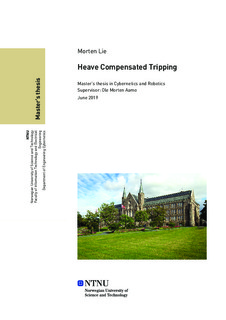| dc.contributor.advisor | Aamo, Ole Morten | |
| dc.contributor.author | Lie, Morten | |
| dc.date.accessioned | 2019-10-31T15:11:06Z | |
| dc.date.issued | 2019 | |
| dc.identifier | no.ntnu:inspera:35771502:16080755 | |
| dc.identifier.uri | http://hdl.handle.net/11250/2625728 | |
| dc.description.abstract | Olje- og gassindustrien blir møtt med store utfordringer når nye brønner skal bores fra flytende plattformer. En av disse utfordringene er trykkvariasjoner i brønnen forårsaket av bevegelse av boreutstyret. Siden havbølger har innflytelse på den relative posisjonen til en flytende borerigg i forhold til havbunnen, kan slike bølgebevegelser indusere trykkbølger nede i borehullet. Trykkbølger med tilstrekkelig styrke kan resultere i hydraulisk frakturering av formasjonen i reservoaret, som videre kan resultere i uønskede lekkasjer. Ved heising av boreutstyr blir ikke slike bølgeskapte bevegelser kompensert for på borerigger i dag. Dette begrenser boreoperasjoner til bestemte sjøganger.
Denne avhandlingen beskriver en kontrollstrategi som bruker heisesystemet til å isolere bevegelsene av boreutstyret fra de bølgeskapte bevegelsene boreriggen utsettes for under heiseoperasjoner. En matematisk modell av et konvensjonelt heisesystem er utledet og simulert sammen med en modell som beskriver dynamikken i brønnen. Analyser basert på simuleringer beskrevet i denne rapporten viser at konvensjonell trykkregulering av brønn som brukes på borerigger i dag, kombinert med aktiv kompensering for hivbevegelse under heising, gir en reduksjon av trykkbølger med en faktor på seks. Ved å oppnå slike resultater vil man i praksis kunne redusere nedetid på grunn av vær, samt øke sikkerheten på plattformen. | |
| dc.description.abstract | The oil and gas industry are facing numerous challenges when drilling new wells from floating vessels. One of these challenges is pressure oscillations induced in the well hole by movement of the drilling equipment. Since the relative position of a floating drilling rig to the seabed is influenced by waves, these motions may induce pressure waves in the well hole. Pressure waves with sufficient amplitude may result in fracking of the formation in the reservoir, rendering damage to the structural integrity of the well. Furthermore, during hoisting operations of the drilling equipment, these wave-induced motions are not compensated for on drilling rigs today, thus limiting the drilling operations to particular sea states.
This thesis proposes a control strategy that utilizes the hoisting system to isolate the movement of the drilling equipment from the wave-induced motion of the rig during hoisting operations. A mathematical model of a conventional hoisting system is derived and simulated together with a model describing the dynamics in the well. The analysis based on simulations presented in this work suggest combining conventional pressure control used on modern drilling rigs with active hoisting. In the simulations where the sea state was configured based on data from the North sea, the pressure oscillations were reduced by a factor of six when comparing the proposed control system with the conventional tripping method. Achieving such results in practice will reduce weather related down time, and increase safety on the platform. | |
| dc.language | eng | |
| dc.publisher | NTNU | |
| dc.title | Heave Compensated Tripping | |
| dc.type | Master thesis | |
